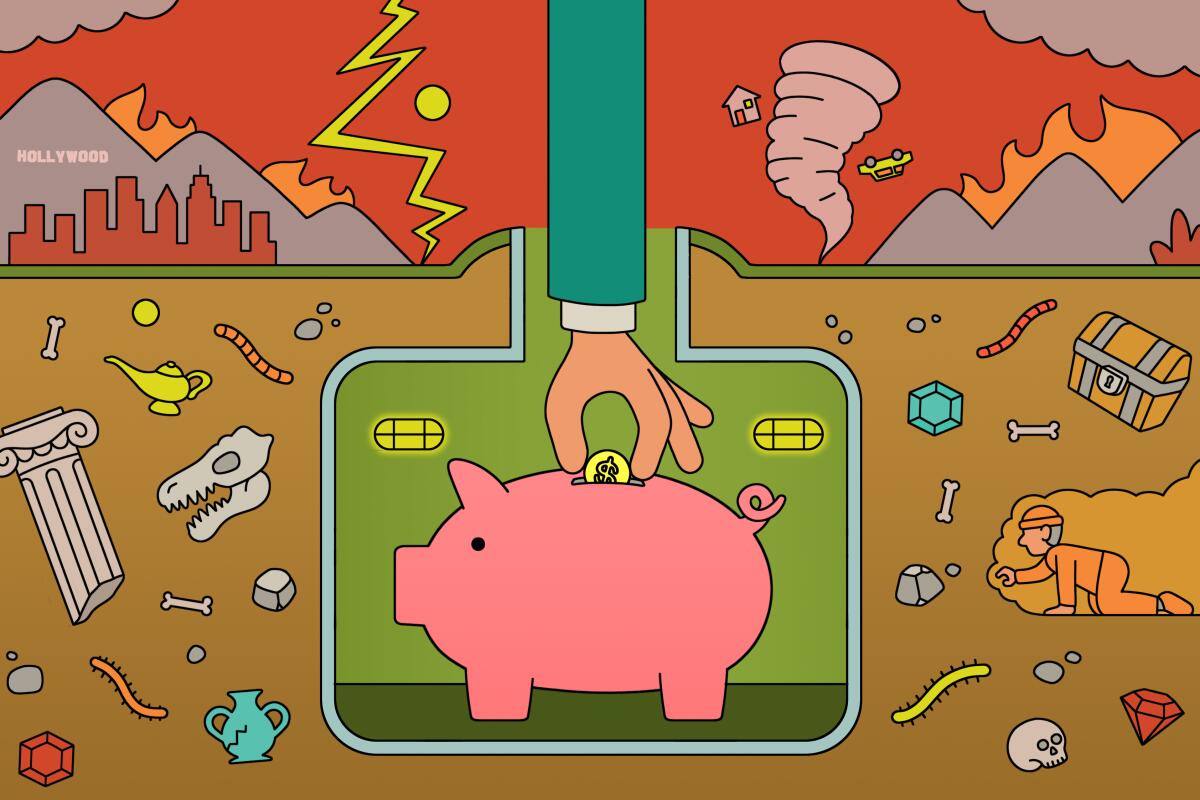Totally Worth It, Week 4: Create an emergency fund

- Share via
It’s time to add a new line item to your budget: your emergency fund.
You’ve probably read somewhere that you should have three to six months’ worth of expenses set aside. For most people, that is an astronomical amount. Do not add up your expenses, multiply by six and fixate on that number.
Close to 40% of Americans could not afford a $400 unexpected expense without having to carry a balance on a credit card or borrow money or sell something. That’s not just among people with student loan debt, or people in their 20s and 30s, or people who just started budgeting. That’s almost 40% of everyone in the United States.
If you have $100 set aside for an emergency, you’re ahead of a lot of people. If you get to $400, you’re ahead of well over a third of the people who live in America. When you look at it that way, you realize how rare having half a year’s expenses set aside really is.
How much should be in my emergency fund?
Start small. Again, every dollar you get into this category is a victory. Set $400 as your first goal. Work your way up from there.
If you are in hard-core debt paydown mode, it might seem foolish to have money just sitting in your bank account, not doing anything. But it is doing something: It’s waiting for an inevitable emergency. That money is the National Guard of your budget, ready to mobilize at a moment’s notice.
If you throw every single spare dollar you have at your debt, what will you do when an emergency happens? You will cycle right back into debt. That’s not progress.
Some personal finance gurus say to have a $1,000 fund when you get started, and $1,000 is a good number. I think that, given how expensive things are in Southern California, $2,000 makes more sense as a workable amount to have on hand. It’ll cover most unexpected expenses.
When you spend from your emergency fund, you have to prioritize paying yourself back. That might mean rejiggering your budget for the next couple of months to “top up” that emergency reserve before throwing extra at debt, or cutting back on discretionary expenses for a bit. No fun, I know! But it’ll be worth the peace of mind when something bad happens and you can say, “No problem.”
Once you’ve got a good handle on your debt, then it’s time to think about becoming one of those super savers with three to six months of cushion in your savings account.
By the way, that should be three to six months of absolutely necessary expenses, not total outflow. If there’s an emergency, you probably aren’t thinking much about your dining-out budget. A theoretical month of emergency savings should be enough to cover your necessities (rent, utilities, food, transportation) and debt payments, not the maximum amount you spend per month.
What constitutes an emergency?
To me, an emergency is an expense you couldn’t have foreseen. A last-minute flight across the country for a funeral. Having to move unexpectedly and needing the deposit for a new place before you get your security deposit back.
One that millions of people encountered in 2020: losing your job and having to pay your bills out of pocket until unemployment kicks in.
With this eight-week newsletter course from the Los Angeles Times, assistant editor Jessica Roy will help you get a handle on your money stuff.
Where do I keep my emergency fund?
In my opinion, you need only two bank accounts: checking and interest savings. If you’ve combined finances with someone else, maybe you want one more checking account for your personal fun money. That’s it, though. Some people have one shared checking account for necessities and one shared for fun stuff and another personal account and then separate savings accounts for each savings goal. To me, if you’re budgeting correctly, that just creates a lot of extra work. I keep the “someday funds” and my emergency fund in the savings account that earns a little interest, and everything else in checking. (Getting to budget the interest on your savings is one of budgeting’s great joys. Yes, thank you, I would like the money that my money earned to go toward my future vacation.)
This is not a newsletter about investing. If you want to invest, great! A separate investment account is a good thing, as is contributing to an employer-sponsored retirement account. A budget line for what you can afford to put into it every month, even better. But despite the high yields in the market right now, it’s not smart to put your rainy-day money into stocks. The kinds of emergencies that lead to things like job or home loss sometimes come from much larger societal emergencies — the kind that bring the market crashing down and take your hard-earned savings with it.
What about my ‘someday funds’ that I made in Week 1?
If you followed along on Week 1 when we made our budgets, you’re already setting aside a little bit for things like car repairs and vet bills and medical expenses. Some people think of those as emergency expenses. I don’t.
I mean, yes, obviously, if your car engine dies, it’s an emergency. But if you’ve ever owned a car, or a pet, or a human body, you know they break down and need repairs sometimes. The only unexpected part is the “when.” So I like to save for these separately, stashing away a little bit of money every month so that when the car’s serpentine belt or the dog’s ACL blows out, I’m ready.
If you need more than what’s in the car or pet fund at that point, especially when you’re just starting to build those up, take it from your emergency savings. But in the long run, the goal is to be able to say, “Oh, the car needs new brakes? That’s fine. We’ve been saving for this.”
Not everyone would agree with how I categorize these types of expenses. If you’d rather throw more money at your monthly emergency fund and not save separately for individual categories, that’s OK too! As I said before, your brain, your priorities and your budget are all going to be different from mine. I’m giving you the information and empowering you to figure out how to use it.
We put only a couple of those “someday funds” into the budget in Week 1 because I didn’t want to totally overwhelm you. Honestly, there are a lot of “somedays” to save up for. As I write this, I am saving up for both the deductible and the out-of-pocket max on my health insurance for when I have a baby. My car is 10 years old and I plan to run it into the ground, but it won’t last forever, so a new-car fund is on my budget. When my husband and I decided to upgrade our phones, that was a new “someday” category. The farther away those expenses are, the less you have to put aside every month to fully fund them by the time they pop up. You don’t have to put every single expense you’ll ever have into your budget right now, but keep in mind as you go on your budgeting journey that there’s stuff you’ll want down the road, and the right time to start saving for them is now.
Hang in there
Are you panicking? Maybe a little? It’s hard to pay off debt and also feel as though you need to save up for 10,000 things you will want and need in the future, plus a bunch more things you can’t even think of right now. It’s a lot. Just start small.
You’re doing great.
Next week, we’ll talk about how to tackle debt so you’ll have more money for the big goals and fun stuff.
— Jessica
P.S.
This newsletter is free. But making it is not. Totally Worth It won’t have any sales pitches for specific financial products — i.e., I’ll never tell you that you need to buy this specific software or open an account with this specific bank. My only sales pitch is this one: If you aren’t already, please consider subscribing to the Los Angeles Times. For a budget-friendly $1, you can try it out for a limited time.
The Totally Worth It team wants to hear from you! If you have any thoughts, questions or concerns, email [email protected]. And to ensure you get this newsletter, please add this email address to your contacts or address book. Thanks.
Inside the business of entertainment
The Wide Shot brings you news, analysis and insights on everything from streaming wars to production — and what it all means for the future.
You may occasionally receive promotional content from the Los Angeles Times.





